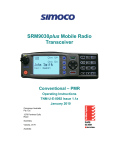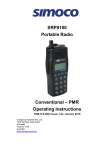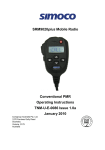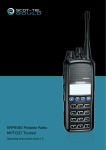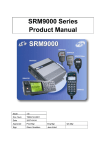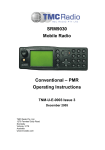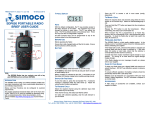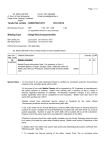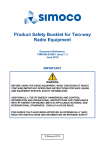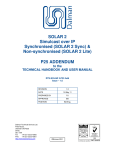Download Simoco SRP9180 User manual
Transcript
SRP9170 / SRP9180 Portable Radio Conventional – PMR User Manual TNM-U-E-0089 Issue 1.4a August 2009 Comgroup Australia Pty. Ltd. 1270 Ferntree Gully Road Scoresby Victoria, 3179 Australia www.simoco.com.au SRP9170 and SRP9180 ~ PMR Portable Radio User Manual Associated Documentation The following documentation is available for use with the SRP9170 and SRP9180 series of products: TNM-U-E-0088 TNM-U-E-0090 TNM-U-E-0091 TNM-U-E-0095 TNM-U-E-0102 SRP9180 PMR Brief User Guide SRP9180 MPT1327 User Manual SRP9180 P25 User Manual SRP9180 P25 Brief User Guide SRP9180 Brief User Guide (General) To order copies of any of the above publications, or any other Simoco product, contact Comgroup Australia on +61 3 9730 3800 or send a Fax on +61 3 9730 3968. The Simoco web site also has a comprehensive list of documentation available for download. www.simoco.com.au About This Document This publication is copyright and no part may be reproduced without prior permission of ComGroup Australia. Due to our policy of continuous improvement to our products and services, technical specifications and claims, correct at time of publication, may be subject to variation without prior notice. ComGroup Australia has endeavoured to ensure that the information in this document is fairly and accurately stated, but does not accept liability for any errors or omissions. Conventions Where the word “generally” or “may” is used to describe a facility, this operation is an option that may be enabled with the FPP. In some cases, key functions will be determined by the customer configuration, so when a key function is referred to in these instructions, the function may be assigned to another physical location than designated here. Where the term SRP9180 is used, reference can also be applied to the SRP9170, except where the keypad is used. © ComGroup Australia 2010 page 2 TNM-U-E-0089 Issue 1.4a SRP9170 and SRP9180 ~ PMR Portable Radio User Manual General Safety Do NOT operate your portable radio, without a handsfree kit, whilst driving a vehicle. Do NOT operate your radio in an explosive atmosphere – unless the radio’s level of IECEx approval is approved for use in that atmosphere. Obey the 'Turn Off Two-way Radios' signs where these are posted, e.g. on a petrol station forecourt. Do NOT touch the antenna while the radio is transmitting. Do NOT dispose of batteries in a fire. Do NOT operate the radio if the antenna has become disconnected or damaged. Only recharge batteries in an approved battery charger. IECEx Intrinsically Safe Radios Radio models approved for use in hazardous environments according to the IECEx Scheme are marked with an approval number. Refer to the label on the radio for the IECEx compliance level. The following MUST be observed to maintain the IECEx protection rating: • Use only approved SIMOCO battery, part number PAR-9180BATL2i or PAR-9180BATL3i. • Battery charging must only be carried out in non-hazardous areas, using an approved battery charger. • Metal belt clips must NOT be used in hazardous areas. • It is a requirement that when the radio is used in a hazardous area that either the SRP9180 Accessory Cover Assy (6102 350 1446) or an approved Simoco IECEx accessory is fitted (refer Section 8 for list of approved accessories). • Approved accessories may only be connected and disconnected outside the hazardous areas. • Prior to use in a hazardous area, inspect the radio and accessories for signs of damage. Any visible signs of damage to the radio or accessories may compromise the integrity and safety of the radio. A damaged radio or accessories must be repaired or replaced prior to use in a hazardous area. • Incorrect storage, handling or operation of the radio and accessories, as specified in Simoco published User Guides and Service Manuals, may compromise the safety and integrity of the radio or accessories. • Approved labels stating the IECEx rating level must be on the radio and accessories, and be legible, before their use in a hazardous area. • Servicing and upgrades of IECEx approved Intrinsically Safe radios and accessories must only be carried out by Simoco P/L IECEx Intrinsically Safe trained staff, at locations that have been IECEx approved. Please contact the Simoco Help Desk on 1300 363 607 for your nearest approved Service Department. • Substitution of parts or accessories will void the equipments’ IECEx Intrinsic Safety rating. © ComGroup Australia 2010 page 3 TNM-U-E-0089 Issue 1.4a SRP9170 and SRP9180 ~ PMR Portable Radio User Manual Hints for Using the Radio When transmitting, hold the radio a few centimetres from your mouth and speak across it, rather than into it. The microphone is located near the bottom right hand corner of the portable radio’s speaker grille. Keep the length of your conversation to a minimum to conserve battery life. When it is possible to move location, avoid making calls from known poor signal-strength areas such as the radio systems fringe areas (limit of range) or from screened or shadowed areas, e.g. an underground car park or underpass. © ComGroup Australia 2010 page 4 TNM-U-E-0089 Issue 1.4a SRP9170 and SRP9180 ~ PMR Portable Radio User Manual CONTENTS 1. INTRODUCTION ................................................................................. 8 1.1 Overview............................................................................................................ 8 1.2 Configuration .................................................................................................... 8 2. FRONT PANEL CONTROLS .............................................................. 9 3. MENU SYSTEM................................................................................. 10 3.1 4. Menu Navigation ............................................................................................. 10 MAIN MENU SCREENS.................................................................... 12 4.1 Channel Screen............................................................................................... 12 4.2 Phonebook Screen ......................................................................................... 13 4.3 Status Screen.................................................................................................. 13 4.4 Send Message Screen .................................................................................... 14 4.5 Stored Calls Screen (Selcall) ......................................................................... 15 4.6 Stored Calls Screen (Data Messages)........................................................... 16 4.7 Setup Screen................................................................................................... 17 5. COMMON FUNCTIONS AND FACILITIES ....................................... 18 5.1 Switch-On/Switch-Off ..................................................................................... 18 5.1.1 Volume Adjustment .................................................................................... 18 5.2 Channel Change ............................................................................................. 18 5.3 3 Position Function Switch ............................................................................ 18 5.4 Receiving......................................................................................................... 18 5.5 Transmitting .................................................................................................... 19 5.6 SELCALL Functions ....................................................................................... 20 5.6.1 Receiving a Selcall ..................................................................................... 20 5.6.2 Sending a Selcall........................................................................................ 20 5.6.3 Other Selcall Functions .............................................................................. 20 5.7 Scan Functions ............................................................................................... 21 5.7.1 Scan Screen............................................................................................... 21 5.7.2 Scan-Edit Screen ....................................................................................... 22 6. 5.8 DTMF Operation .............................................................................................. 23 5.9 Keypad Lock ................................................................................................... 23 SETUP ............................................................................................... 24 © ComGroup Australia 2010 page 5 TNM-U-E-0089 Issue 1.4a SRP9170 and SRP9180 ~ PMR Portable Radio User Manual 6.1 Setup Sub-Menus............................................................................................ 24 6.1.1 User Options .............................................................................................. 24 6.1.2 Mute Adjust ................................................................................................ 25 6.1.3 Contrast...................................................................................................... 25 6.1.4 Alert Volume............................................................................................... 25 6.1.5 Radio Information ....................................................................................... 26 6.1.6 Phone Book Edit Menu............................................................................... 27 6.1.7 Network Selection ...................................................................................... 29 7. SPECIAL FUNCTION KEYS ............................................................. 30 7.1 Monitor............................................................................................................. 30 7.2 Squelch Defeat ................................................................................................ 30 7.3 Reset ................................................................................................................ 30 7.4 Send-2.............................................................................................................. 30 7.5 Transpond ....................................................................................................... 30 7.6 CTCSS.............................................................................................................. 30 7.7 Mute ................................................................................................................. 30 7.8 Goto Chan A, B, C, D ...................................................................................... 30 7.9 Special Enc 1…8 ............................................................................................. 30 7.10 Alarm ............................................................................................................ 30 7.11 Repeater Defeat (Talkaround)..................................................................... 30 7.12 Low Power.................................................................................................... 30 7.13 DTMF Mode .................................................................................................. 31 7.14 Scrambler On/Off......................................................................................... 31 7.15 Send DTMF1/2.............................................................................................. 31 7.16 User CTCSS ................................................................................................. 31 7.17 Send Channel Encode................................................................................. 31 7.18 Channel Up and Down ................................................................................ 31 7.19 Mode ............................................................................................................. 31 8. ACCESSORIES................................................................................. 32 8.1 Lithium Ion Battery (PAR-9180BATL2x)........................................................ 32 8.2 Lithium Ion Battery (PAR-9180BATL2).......................................................... 32 8.3 Lithium Ion Battery (PAR-9180BATL3x)........................................................ 32 8.4 Lithium Ion Battery (PAR-9180BATL3).......................................................... 32 8.5 Single Pocket Charger (PAR-9180CRG1)...................................................... 32 8.6 Two Pocket Charger (PAR-9180CRG2) ......................................................... 32 8.7 Six Pocket Charger (PAR-9180CRG6) ........................................................... 32 © ComGroup Australia 2010 page 6 TNM-U-E-0089 Issue 1.4a SRP9170 and SRP9180 ~ PMR Portable Radio User Manual 9. 8.8 Vehicle Mounted Charger (PAR-9180CRGV) ................................................ 32 8.9 Lightweight Carry Case (PAR-9180CLBC2).................................................. 32 8.10 Lightweight Carry Case (PAR-9180CLBC3)............................................... 32 8.11 Heavy Duty Carry Case (PAR-9180CHSM)................................................. 32 8.12 Lightweight Lapel Function Speaker Microphone (PAR-9180LMS2) ...... 32 8.13 Four Function Speaker Microphone (PAR-9180LMS4)............................. 32 8.14 Four Function Antenna Speaker Microphone (PAR-9180LMR4) ............. 32 8.15 GPS Microphone (PAR-9180LMGM)........................................................... 33 8.16 Earpiece (PA-LMEP8) .................................................................................. 33 8.17 Programming Lead (MAR-9180PRLDU ...................................................... 33 8.18 Belt Clip (PAR-9180CLIP)............................................................................ 33 8.19 Stud Mount (PAR-9180STUD) ..................................................................... 33 TROUBLESHOOTING ...................................................................... 34 10. APPENDIX A - ALERT TONES AND MESSAGES .......................... 35 11. APPENDIX B - GLOSSARY.............................................................. 36 12. COMPLIANCE WITH RF ENERGY EXPOSURE GUIDELINES (UNITED STATES AND CANADA) ........................................................... 37 © ComGroup Australia 2010 page 7 TNM-U-E-0089 Issue 1.4a SRP9170 and SRP9180 ~ PMR Portable Radio User Manual 1. INTRODUCTION 1.1 OVERVIEW The SRP9180 radios are versatile Digital Signal Processor (DSP) controlled, two-way portable radios. The radios are software programmable and can be customised to the operational requirements of your particular fleet. Your Simoco representative can help in programming your radio facilities to meet your present and future requirements. A wide-range of accessories is available to complement the SRP9180 radios including: chargers, antenna, headsets, covert kits, holsters and carry cases. Refer to Simoco for comprehensive descriptions. This guide describes the facilities that are currently available and can be programmed into the Private Mobile Radio (PMR) mode of the SRP9180 radios. The SRP9180 model features a keypad and 7 function keys, the SRP9170 model has 7 function keys. 1.2 CONFIGURATION Before you can use the SRP9180, it must be configured using the Field Personality Programmer (FPP). The configuration process loads the customised channels, signalling and user options so that the radio will operate with your system. Although this manual defines the configuration and use of the PMR mode, the radio can be configured easily to operate in other modes using the FPP. © ComGroup Australia 2010 page 8 TNM-U-E-0089 Issue 1.4a SRP9170 and SRP9180 ~ PMR Portable Radio User Manual 2. FRONT PANEL CONTROLS Selector Switch Antenna ABC Switch Function #7 On/Off Volume Indicator LED Function #5 Function #6 Accessory Connector PTT Function #3 Function #4 Function #2 Function #1 Keypad Figure 1 SRP9180 Portable Layout CONTROL FUNCTION On/Off/Volume Rotate clockwise to turn on the radio and then set volume to desired level. Selector Switch Rotate the switch to select the desired channel. ABC Switch Programmer configurable 3 position function switch. Rx/Tx/Power LED Green LED illuminates when receiving a signal. Red LED illuminates when the radio is transmitting. Flashing Red LED indicates low battery. Push-to-Talk. Hold the radio 10cm from the mouth. Press and hold the PTT switch and speak. Release to listen. Used to select channel numbers, set status and send DTMF or Selcall. PTT Keypad Function Key F1 M Function Key F2 ▼ Function Key F3 ▲ Function Key F4 OK Special Function F5 Programmer configurable function key. It is typically programmed as the Menu Select key. Programmer configurable function key. It is typically programmed as the Down key for scrolling. Programmer configurable function key. It is typically programmed as the Up key for scrolling. Programmer configurable function key. It is typically programmed as the Send Channel Encode key. Note that during menu operations it becomes the Confirm key. Programmer configurable function key. Special Function F6 Programmer configurable function key. Special Function F7 Programmer configurable function key. It is typically programmed as the Alarm / Emergency key. © ComGroup Australia 2010 page 9 TNM-U-E-0089 Issue 1.4a SRP9170 and SRP9180 ~ PMR Portable Radio User Manual 3. MENU SYSTEM The SRP9180 radio software uses a programmed menu structure to enable the operator to access the radio options. The structure of the menu can be configured to meet the customer’s specific needs using of the FPP. Figure 1 (overleaf) illustrates the menu structure of the radio. Note that the order and presence of each menu is determined by the configuration of the radio programmed by the FPP. The Setup sub-menus provide access to radio setup parameters. Possible Menu entries are: Phone Book Zone Status Stored Calls Mute Adjust Setup User Options User CTCSS Phone Book Edit Contrast Alert Volume Radio Information Mode Selection or Network Selection Received Signal Strength Indication (RSSI) Lone Worker Send Message To assist the user in menu key selection, a soft menu label will often appear above the function keys. The label shows the user the current function for that key which may change between different menus. Programming of menus is a configuration task normally performed by the system manager using the FPP. 3.1 MENU NAVIGATION The M key is generally used to select Menu mode from the main Channel Screen. Once in Menu mode, the ▼/▲ keys cycle through the menus. To exit Menu mode, press the M key again or the Menu timeout will exit automatically. Generally, pressing the M key while in a menu backs up to the next highest level of menu and the OK key selects the function. The ▼/▲ keys are generally used to navigate through a list of options, or to increase or decrease a value. © ComGroup Australia 2010 page 10 TNM-U-E-0089 Issue 1.4a SRP9170 and SRP9180 ~ PMR Portable Radio User Manual OK OK Key M Note: Example Menus only M Key Up Key Down Key M SubMenu #1 Menu #4 M Phone Book Edit Setup OK M Menu #3 M Stored Calls OK M Menu #2 M Status OK M List / Delete Stored Calls List of Status Selections M Menu #1 Lists Users and Names Phonebook M M M OK M SubMenu #4 User Options SubMenu #3 Alert Volume OK M Contrast User Options Screen Alert Volume Screen OK M SubMenu #2 OK Phone Book Edit Screen OK SubMenu #X Screen M Channel Screen Channel ENTRY POINT = Default Screen Figure 1 Menu Navigation © ComGroup Australia 2010 page 11 TNM-U-E-0089 Issue 1.4a SRP9170 and SRP9180 ~ PMR Portable Radio User Manual 4. MAIN MENU SCREENS 4.1 CHANNEL SCREEN The Channel Screen shows the current channel and allows it to be changed. The RSSI Bars indicate the signal strength of the current channel. Channel Number. The Name Field shows the selected entry from the current Screen (e.g. from Channel List). The Message Line provides additional information in the Screen. (e.g. name of Voting or MultiAx channel when stopped on a channel). Displayed Labels show the current function of the F1 and F4 keys. Pressing one of these keys will execute the function. The Icon Area displays various icons as described in the table below. The Battery Bars indicate the state of battery charge. Several Icons can be displayed in the Icon Line as shown below. ICON INDICATION A filled speaker icon indicates that a signal is present and the radio is unmuted. The outline speaker icon indicates that a signal is present and the radio is muted. This could be another user group, for instance. Received Signal Strength Indication (RSSI). A stronger signal will display more bars. Scan/Search Indicator. When radio is on a scan or vote channel and scanning, the arrow will rotate. The envelope icon indicates there are one or more stored calls. Transmit indicator. * The asterisk symbol indicates whether the radio has been “called” or is in the “on-call” state. Key-lock indicator. © ComGroup Australia 2010 page 12 TNM-U-E-0089 Issue 1.4a SRP9170 and SRP9180 ~ PMR Portable Radio User Manual The ▼/▲keys are used to change the channels from the channel screen. The portable’s selection switch may also be used to change channels. The Keypad may also be used to enter numbers directly, which temporarily appear on the Message Line (overwriting the Channel Name), e.g. Changing channels from the keypad can be done by entering the channel number and pressing the # key. Note: 4.2 If DTMF is enabled then pressing keypad keys will send the corresponding DTMF tone whilst the PTT is pressed. PHONEBOOK SCREEN The Phonebook lists the Radio Users and their Selcall codes. Selcall Identity information is stored for various users and calls can be sent from this Screen. The ▼/▲ keys scroll through the Phonebook entries. Pressing the OK key will place a call to the displayed identity. Alternatively, if the Identity Number is known, the Keypad can be used to enter the number, which is sent when the OK key is pressed (whilst in the Phonebook Screen). The F6 key (when configured for Reset, or any other key configured for Reset) will backspace through keypad-entered numbers, or it will exit back to the Idle Screen if no keypad-entered numbers remain on screen. The Back key returns you to the Menu Select Screen. Refer to section 4.2 for details on Phonebook sub-menus. Notes: 1. If the Selcall requires a Status to be included then the Saved-Status-Value will be used (see description of Status below). 2. The Identity shown on the display when this Screen is exited may be referenced from other Menu Screens and is called the Current-Phonebook-Entry. 4.3 STATUS SCREEN The Status Screen is used to send short pre-programmed messages, e.g. “at lunch”, “job complete” and so on. The Selcall Status is selected here and can be sent from this Screen. The ▼/▲ keys scroll through the Status List entries. Pressing the OK key will send the displayed Status to the Current-Phonebook-Entry. Alternatively, if the Status Number is known, the Keypad can be used to enter the number, which is sent (to the Current-Phonebook-Entry) when the OK key is pressed. The F6 key (when configured for Reset, or any other key configured for Reset) will backspace through keypad-entered numbers, or it will exit back to the Channel Select Screen if no keypad entered numbers remain on screen. The Back key returns you to the Menu Select Screen. Notes: 1. When a Status is sent, it becomes the current Saved-Status-Value, and can be used at a later time from other Menu Screens. © ComGroup Australia 2010 page 13 TNM-U-E-0089 Issue 1.4a SRP9170 and SRP9180 ~ PMR Portable Radio User Manual 2. The Saved-Status-Value can also be set from the Channel or Phonebook Screens by entering the number (from the Keypad) and pressing the * key. The value is saved but not sent. 4.4 SEND MESSAGE SCREEN This Screen allows the user to send a free-form text message to another radio user in a similar manner to a mobile phone SMS. After selecting the Send Message menu option with the OK key, a flashing cursor will appear on the lower LHS of the screen. Each keypad button is labelled with up to 4 text characters (eg. 7=PQRS). The text characters are entered by pressing the keypad once for the first character, twice for the second, and three times for the third, and so on. After a short delay, the cursor will advance to the next character entry. To move the cursor left or right, use the ▼/▲ keys. To delete a character, move the cursor over the character, then press the F6 key (when configured for Reset, or any other key configured for Reset). A total of 237 characters may be entered. When the message is complete, press the OK key to send it. The screen will then prompt for the address to send it to with “Enter No.”. Enter the data address and then press OK. The message will be sent. After the message is sent, the display will indicate whether the message delivery was successful with “Confirmed” if delivered and “Call Failed” if the message could not be delivered. © ComGroup Australia 2010 page 14 TNM-U-E-0089 Issue 1.4a SRP9170 and SRP9180 ~ PMR Portable Radio User Manual 4.5 STORED CALLS SCREEN (SELCALL) This Screen allows the ten most recent missed Selcalls (ones not answered before the alert-tone stopped) and received Status Selcalls to be reviewed. icon will show in the Main Channel Screen when The there is an entry in this Screen. A "Bip" tone is emitted every few seconds when a new call is stored here. Press the M key and the ▼/▲ keys to access the Stored Calls Screen. The most recent call is shown whenever this Screen is accessed. The displayed text identifies the caller (e.g. John Smith) and, if used, Status text (e.g. Call Depot) is displayed on the Message Line. Press the Back key to return to the Menu Select Screen without making a call. The ▼/▲ keys scroll through any other Stored Calls. The number displayed in the top right hand side of the screen (e.g. #05) shows the queued position of the entry. For other functions, press OK for the options pop-up menu. The ▼/▲ keys allow selection within the pop-up box. © ComGroup Australia 2010 page 15 TNM-U-E-0089 Issue 1.4a SRP9170 and SRP9180 ~ PMR Portable Radio User Manual 4.6 STORED CALLS SCREEN (DATA MESSAGES) Received data messages are stored in the Stored Calls screen. Data messages may be up to 237 characters in length. icon will show in the Main Channel Screen when The there is an entry in this Screen. A "Bip" tone is emitted every few seconds when a new call is stored here. Use the M key and the ▼/▲ keys to select the Stored Calls screen. The most recent call is shown whenever the Stored Calls Screen is accessed. (Note that data messages may also be displayed immediately when received, if configured to do so by the FPP). The displayed text identifies the caller (e.g. #02) by their data address. For example “ID: 00102”. If the caller is the dispatcher as identified by the FPP, the callers identity is not shown. The ▼/▲ keys scroll through any other Stored Calls, with the displayed number (e.g. #02) showing the queued position of the call entry. To access message options, press OK and a pop-up selector box will appear. The ▼/▲ keys allow selection within the pop-up box. To view a long message that does not fit on the screen, select More in the pop-up window. To delete the currently displayed message, select Delete in the pop-up window. To exit and return to the channel screen, select Exit in the pop-up window © ComGroup Australia 2010 page 16 TNM-U-E-0089 Issue 1.4a SRP9170 and SRP9180 ~ PMR Portable Radio User Manual 4.7 SETUP SCREEN Use this Screen to access the other Setup sub-menus. Press the OK key to show the first of the sub-menus, and then the ▼/▲ keys to scroll through these screens. Refer to section 6 for details on Setup sub-menus. © ComGroup Australia 2010 page 17 TNM-U-E-0089 Issue 1.4a SRP9170 and SRP9180 ~ PMR Portable Radio User Manual 5. COMMON FUNCTIONS AND FACILITIES 5.1 SWITCH-ON/SWITCH-OFF Turn the On/Off/Volume knob clockwise to switch the portable radio On. The display will illuminate and show a ‘Welcome Message’ and the Selcall Identity of the radio. After a brief time the display will revert to the Idle Screen, at which time the radio is ready for use. Turning the On/Off/Volume knob anti-clockwise will switch the portable radio Off. If the radio Power Down Timer is enabled, the radio will automatically turn Off after a predefined duration of inactivity as set by the FPP (i.e. no keys pressed). The radio will emit warning beeps for 10 seconds prior to switching off. Pressing any key will reset this timer. 5.1.1 Volume Adjustment The top On/Off/Volume knob adjusts the speech level at the loudspeaker or remote speaker microphone. Rotating clockwise increases the volume and anti-clockwise decreases the volume. Note: 5.2 The radio may be programmed so that the volume cannot be completely turned off. CHANNEL CHANGE Changing channels may be achieved by any of the following: Rotating the top mounted Channel Change control. Pressing the ▼/▲ keys. Entering the desired channel number from the Keypad and pressing # (e.g. 1 2 #). Pressing a Go-to-Channel Function Key (refer to Section 7.8). 5.3 3 POSITION FUNCTION SWITCH The 3 Position Function Switch located below the Channel Change control is configurable via the FPP. By default it is not configured. 5.4 RECEIVING The radio will listen on the displayed Channel. will show when a valid signal The Solid Speaker Icon is being received and audio will be heard at the loudspeaker. An Outline Speaker Icon will show if a signal is present but the audio is muted for some reason (e.g. incorrect CTCSS tone, or the Selcall Mute is closed). Note: If the displayed channel is a Vote or Multiax channel then the Rotating Arrow symbol will be displayed while the radio is searching for a signal. When stopped on a channel the Rotating Arrow disappears and the selected Channel Name may be displayed. © ComGroup Australia 2010 page 18 TNM-U-E-0089 Issue 1.4a SRP9170 and SRP9180 ~ PMR Portable Radio User Manual 5.5 TRANSMITTING To avoid interfering with other users of the channel, listen first to ensure no transmissions are is not shown. occurring. Make sure that the Outline Speaker Icon Hold the portable a few centimetres from the mouth, press the Press-To-talk (PTT) switch and note that the Tx Light Emitting Diode (LED) is Red. Speak clearly across the face of the portable in a normal conversational manner. Note that the microphone is located near the bottom right hand corner of the portable radio’s speaker grille. In most systems it is important to wait a short time between pressing the PTT and commencing to speak. This ensures that the path is properly established and avoids lost or truncated speech. Use the correct operating procedure and keep transmissions short. Release the PTT as soon as you finish speaking your message. Notes: 1. A channel may be programmed as “Receive-only” or “Transmit Inhibit” which disallows PTT while the radio is receiving a signal. A continuous tone will be heard if PTT is disallowed. 2. A Transmit Limit Timer may be setup that limits a continuous transmission on a channel. The last 10 seconds before the timer expires may be accompanied by warning tones. 3. The radio may be programmed to send a Selcall (ANI) when the PTT is pressed or released. This may introduce a short delay before the microphone is enabled or after PTT is released. © ComGroup Australia 2010 page 19 TNM-U-E-0089 Issue 1.4a SRP9170 and SRP9180 ~ PMR Portable Radio User Manual 5.6 SELCALL FUNCTIONS Selcall is a PMR signalling option that allows the portable radio to initiate or respond to an identifying number. Selcall is generally used to allow individual radios (or groups of radios) in that system to be to be SELectively CALLed. 5.6.1 Receiving a Selcall A number of different options can be set up by the FPP to sound various alert tones when a Selcall is received. Consult your dealer for a detailed explanation of your radios configuration. When a Selcall is received the radio may respond by: icon to indicate Showing a flashing or solid that the radio has been Called or is On-call, or Sounding an Alert tone, or display the Name of the caller (if it exists in the receivers Phonebook), or the numerical identity of the caller (if unknown) on the display. Pressing the OK key may clear the icon (and/or mute the speaker). 5.6.2 Sending a Selcall Selcalls are generally sent by accessing the Phonebook Screen (page 13) or the Status Screen (page 13). Please refer to these for methods of sending a Selcall. 5.6.3 Other Selcall Functions The SRP9180 has several other functions that affect how the radio operates with received signals or Selcalls. These are described later in this booklet under the following headings: Monitor/Reset Reset Transpond Enable Send-1, Send-2 Special Encode1...8 © ComGroup Australia 2010 (refer to Section 7.1) (refer to Section 7.3) (refer to Section 7.5) (refer to Section 7.4) (refer to Section 7.9) page 20 TNM-U-E-0089 Issue 1.4a SRP9170 and SRP9180 ~ PMR Portable Radio User Manual 5.7 SCAN FUNCTIONS Scanning consists of sequentially searching up to 15 channels for a valid signal (RF, CTCSS or DCS tone). When found the radio will stop on that channel until the signal disappears. While listening on the channel, the User may PTT on that channel. After the signal disappears the radio will remain listening on the channel for a short time (typically 3 seconds) before resuming scanning. If a Priority/Emergency Channel is assigned, the radio will interleave a check of this channel between each normal channel check. The radio may also check the Priority Channel every few seconds while stopped on a channel. If a signal is found on the Priority Channel then the radio will switch to that channel immediately. To activate Scanning, select a SCAN Channel. 5.7.1 Scan Screen The display shows the name of the current Scan-Group (e.g. ScanChGrp), which may be changed using the ▼/▲ keys. The Scan-Group Number is shown at the top-left of the display (i.e. 1, 2, 3, 4) if it is a User Scan-Group, or blank for Fixed Scan-Groups. While the Scan Screen is displayed the radio is scanning the shown group. The RSSI indicator shows the received signal strength as the radio is scanning. All other keys have the same assignments as in the Main Channel Screen. When stopped on a channel, the name of the selected site, and the “rotating arrow” symbol is replaced by the Speaker symbol. To temporarily skip the channel from the Scan-Group, press OK then select Skip. Skipped channels are restored when a different Scan Group is selected or if Scan is exited. The Priority Channel cannot be skipped. OK: Edit is only active for User Scan Groups and opens up the Scan-Edit Screen for the selected Scan Group allowing Channels to be added, deleted or set as the priority channel (see below). While listening on the channel, the User can PTT on that channel. After the signal disappears the radio will remain listening on the channel for a short time before resuming scanning. The Keypad may be used for quick channel change (e.g. 456#). © ComGroup Australia 2010 page 21 TNM-U-E-0089 Issue 1.4a SRP9170 and SRP9180 ~ PMR Portable Radio User Manual 5.7.2 Scan-Edit Screen Press OK and select Scan Edit. In the Scan-Edit Screen the display shows the Channel List (excluding Vote and Multiax channels) and the Message Line shows either “Member” or “Priority”. Press the ▼/▲ keys to show channels within the Scan Group. Press OK to Add/Delete a channel, or Change the Priority Channel. If the ▼/▲ keys were used to select ADD… …Then this Screen will appear. Press OK to confirm channel selection and to return to the previous screen. Alternatively, if the ▼/▲ keys were used to select PRIORITY… …Then this Screen would appear. Press OK to confirm Priority selection and to return to the previous screen. When adding Channels (or changing Priority Channel), press ▼/▲ keys to scroll through all available channels, and press OK to make a selection. In all Screens, press Back to return to previous Screen. Note: “Member” and “Priority” text strings will only be displayed if the channel is a member of the group. © ComGroup Australia 2010 page 22 TNM-U-E-0089 Issue 1.4a SRP9170 and SRP9180 ~ PMR Portable Radio User Manual 5.8 DTMF OPERATION When DTMF is enabled, DTMF tones can be sent using the Keypad from the Main Channel Screen. Pressing 0, 1, ..., 9, * and # will send the associated tones when the PTT is pressed. The tone period and gap are set by the FPP. DTMF is enabled by selecting the DTMF option in the User Options sub-menu (refer to Section 6). 5.9 KEYPAD LOCK The radio has a keypad lock function that may be enabled by the FPP during configuration. If this function is activated, a key icon will be displayed when the keypad is locked. To unlock the keypad, it is necessary to press and hold down the OK key for 2 seconds. After 2 seconds, the key icon will disappear and the keypad will be enabled. The keypad will automatically re-lock after a period of 10 seconds following no key activity. © ComGroup Australia 2010 page 23 TNM-U-E-0089 Issue 1.4a SRP9170 and SRP9180 ~ PMR Portable Radio User Manual 6. SETUP The Setup sub-menus allow the operator to edit/modify the operation of some of the general functions of the radio. The programmer can restructure or restrict access to any or all of these menus and may restructure them according to specific requirements. 6.1 SETUP SUB-MENUS The default Setup sub-menu structure is shown as an example. These sub-menu Screens provide access to the following operator functions. User Options Key beeps, Backlight, Dual Watch & DTMF on/off selection. Mute Adjust Mute Level adjustment. Phone Book Edit Allows Phonebook entries to be changed, deleted or added. Contrast Displays contrast adjustment. Alert Volume Alert “beep” tone level setting (relative to Audio Volume). Radio Information FPP File description, SW version, Serial No. Selcall ID. Network Selects Trunk (Network 1/2), or PMR operation mode. 6.1.1 User Options The User Options Screen allows a variety of user options (such as Keybeeps, Backlight, Dual Watch and DTMF facilities) to be set On or Off. The option selections are set with the FPP. Use the ▼/▲ keys to scroll between the different options. The OK key toggles the selection On/Off. The setting is saved immediately. © ComGroup Australia 2010 page 24 TNM-U-E-0089 Issue 1.4a SRP9170 and SRP9180 ~ PMR Portable Radio User Manual 6.1.2 Mute Adjust Select the Mute Adjust Screen to change current Mute setting. Use the ▼/▲ keys to change the Mute level. Press the OK or Back key to save new Mute setting. Note: When a Voting channel is selected the Voting-Mute level is shown, but can not be changed. 6.1.3 Contrast The Contrast Screen allows you to set the contrast level of the display in the range from 0 to 15. Use the ▼/▲ keys to select the required contrast setting. Press OK or Back to accept the setting and return to the Idle Screen. 6.1.4 Alert Volume This Screen allows you to set the level of the Alert Volume Beep Tone in relation to the current Volume setting. The level can be set in 63 steps over the range -31 to +31. Use the ▼/▲ keys to change the relative alert level. Press OK or Back to accept the setting and return to the Idle Screen. Note: A minimum Alert Level may be set to ensure the Alerts can always be heard from the speaker. © ComGroup Australia 2010 page 25 TNM-U-E-0089 Issue 1.4a SRP9170 and SRP9180 ~ PMR Portable Radio User Manual 6.1.5 Radio Information This Screen displays information that identifies the: Programmer File description, Software Version, Selcall ID, and Radio Serial Number and ESN. Press OK to return to the Idle Screen. Press Back to return to the Menu Select Screen. © ComGroup Australia 2010 page 26 TNM-U-E-0089 Issue 1.4a SRP9170 and SRP9180 ~ PMR Portable Radio User Manual 6.1.6 Phone Book Edit Menu The Phone book Edit Screen allows you to Add, Delete or Edit phone book entries. 6.1.6.1 Add A New Entry From the main Phone Book Edit Screen (at any Phonebook Entry), just press OK. Use the ▼/▲ keys to select “Add” and press OK. Enter the new Entry number using the keypad. And press OK. Next, enter new Entry text using the ABC keypad (see 6.1.6.4 below), And press OK again to exit back to the Idle Screen. © ComGroup Australia 2010 page 27 TNM-U-E-0089 Issue 1.4a SRP9170 and SRP9180 ~ PMR Portable Radio User Manual 6.1.6.2 Edit An Existing Entry Use the ▼/▲ keys to select the required Phonebook Entry, then Press OK. Next, edit the number using the programmed Reset* key and keypad and press OK. Use the ▼/▲ keys to select “Edit” and then press OK. Edit text using the ABC keypad (see 6.1.6.4 below) and press OK to exit back to the Idle Screen. * Note that F6 is often programmed as reset. 6.1.6.3 Delete An Entry Use the ▼/▲ keys to select the required Phonebook Entry, then press OK. Use the ▼/▲ keys to select “Delete”, then press OK to delete the Entry and exit back to the Idle Screen. 6.1.6.4 Using The Keypad for Text When using the keypad to type text: Press the appropriate keypad key a number of times until the desired character or number is selected, The current character position is identified by a flashing block cursor, Use # to select lower/upper case letters, Use the ▼/▲ keys to move to the next or previous character space to be entered/modified, and Press OK to accept changes. © ComGroup Australia 2010 page 28 TNM-U-E-0089 Issue 1.4a SRP9170 and SRP9180 ~ PMR Portable Radio User Manual 6.1.7 Network Selection The Network Screen allow you to switch operation between: Trunk Network 1, Trunk Network 2, PMR mode. P25 mode Use the ▼/▲ keys to make your selection, and press OK to accept. Press Back to return to the Menu Select Screen without changing modes. Note: Refer to the relevant Operating Instructions for Trunk operation. © ComGroup Australia 2010 page 29 TNM-U-E-0089 Issue 1.4a SRP9170 and SRP9180 ~ PMR Portable Radio User Manual 7. SPECIAL FUNCTION KEYS This section lists Functions that may be programmed to the F1, F2, F3, F4, F5, or F6 keys. Selected functions may also be programmed into the 3 Position Function Switch. Consult your Simoco Dealer for which functions have been programmed in to your radio. 7.1 MONITOR Opens/Closes the audio (signalling) mute. Only valid on Non-Community Repeater type channels and/or Closed Selcall channels without Receiver Lock-out programmed. 7.2 SQUELCH DEFEAT Opens/Closes the squelch (carrier) mute. 7.3 RESET Closes the audio (signalling) mute on closed Selcall Channels. 7.4 SEND-2 Sends a specific Selcall sequence. 7.5 TRANSPOND Enables/Disables Individual Call Acknowledge. 7.6 CTCSS Defeats the CTCSS mute on the channel. Only valid on Non-Community Repeater type channels and/or Open Selcall channels. 7.7 MUTE Provides direct access to the Mute Setup Screen (refer to Section 6.1.2) and allows the user to change the mute level from that screen. 7.8 GOTO CHAN A, B, C, D Selects predefined Channel A, B, C or D, and (may) return on the second press. The Defined Channel may be redefined if held for approximately 2 seconds. 7.9 SPECIAL ENC 1…8 Sends Special Encode 1, 2, …, 8. 7.10 ALARM Put the portable into Alarm mode. 7.11 REPEATER DEFEAT (TALKAROUND) Allows the radio to transmit on the reverse frequency on a Repeater Channel. When the key is pressed again (or the Channel is changed) the transmit frequency reverts to the original setting. 7.12 LOW POWER Forces the radio to low power. Pressing again puts the radio back to the power level defined for the current channel. This is not affected by Channel changes. © ComGroup Australia 2010 page 30 TNM-U-E-0089 Issue 1.4a SRP9170 and SRP9180 ~ PMR Portable Radio User Manual 7.13 DTMF MODE This function places the numeric keypad into DTMF mode. refer to Section 5.8. 7.14 SCRAMBLER ON/OFF This function toggles the operation of the frequency inversion voice scrambler. 7.15 SEND DTMF1/2 This function sends a pre-programmed string of up to 16 DTMF digits. 7.16 USER CTCSS If enabled by the Field Programmer, this function will allow the user to select the CTCSS tone to be used. 7.17 SEND CHANNEL ENCODE Sends the encode that has been defined for that particular channel. 7.18 CHANNEL UP AND DOWN These functions change channels in the upward or downward directions. 7.19 MODE This function changes the mode of the radio. The radio can be switched between PMR, MPT1327, P25 and other modes as configured. Press once to view current mode and again within 1 second to step through modes. Release and mode will change to that displayed. Note that the ABC switch on the top of the portable may be programmed for mode change. © ComGroup Australia 2010 page 31 TNM-U-E-0089 Issue 1.4a SRP9170 and SRP9180 ~ PMR Portable Radio User Manual 8. ACCESSORIES The following accessories are available for the SRP9180 portable radio. Contact your Simoco Dealer for further information. 8.1 LITHIUM ION BATTERY (PAR-9180BATL2X) Capacity of 2200 mAh, non Intrinsically safe battery. 8.2 LITHIUM ION BATTERY (PAR-9180BATL2) Capacity of 2200 mAh. Intrinsically Safe – must be used with Intrinsically Safe version of radio for radio to be Intrinsically Safe. 8.3 LITHIUM ION BATTERY (PAR-9180BATL3X) Capacity of 3000 mAh, non Intrinsically safe battery. 8.4 LITHIUM ION BATTERY (PAR-9180BATL3) Capacity of 3000 mAh. Intrinsically Safe – must be used with Intrinsically Safe version of radio for radio to be Intrinsically Safe. 8.5 SINGLE POCKET CHARGER (PAR-9180CRG1) Charger capable of charging one portable radio at a time. 8.6 TWO POCKET CHARGER (PAR-9180CRG2) Charger for two portable radios. 8.7 SIX POCKET CHARGER (PAR-9180CRG6) Charger for up to six portable radios. 8.8 VEHICLE MOUNTED CHARGER (PAR-9180CRGV) Charger for in vehicle charging of the portable. 8.9 LIGHTWEIGHT CARRY CASE (PAR-9180CLBC2) Carry case for light duty use with PAR-9180BATL2/i. This carry case MUST be used with Intrinsically Safe radios. 8.10 LIGHTWEIGHT CARRY CASE (PAR-9180CLBC3) Carry case for light duty use with PAR-9180BATL3/i. This carry case MUST be used with Intrinsically Safe radios. 8.11 HEAVY DUTY CARRY CASE (PAR-9180CHSM) Carry case for heavy-duty use with belt loop attachment. 8.12 LIGHTWEIGHT LAPEL FUNCTION SPEAKER MICROPHONE (PAR-9180LMS2) Combined small speaker and microphone for light duty use incorporating two programmable function keys. 8.13 FOUR FUNCTION SPEAKER MICROPHONE (PAR-9180LMS4) Combined medium duty speaker and microphone incorporating four programmable function keys. 8.14 FOUR FUNCTION ANTENNA SPEAKER MICROPHONE (PAR-9180LMR4) Combined medium duty speaker and microphone incorporating four programmable function keys and radio antenna. © ComGroup Australia 2010 page 32 TNM-U-E-0089 Issue 1.4a SRP9170 and SRP9180 ~ PMR Portable Radio User Manual 8.15 GPS MICROPHONE (PAR-9180LMGM) Speaker Microphone incorporating programmable function keys. GPS receiver for tracking applications and four 8.16 EARPIECE (PA-LMEP8) Earpiece for portable radio. 8.17 PROGRAMMING LEAD (MAR-9180PRLDU USB programming lead for configuring radio personality using Field Personality Programmer. 8.18 BELT CLIP (PAR-9180CLIP) Belt Clip for belt widths of up to 50mm. The clip screws onto the rear of the battery. 8.19 STUD MOUNT (PAR-9180STUD) Klickfast Stud for the Klickfast range of quick docking portable radio attachment options. © ComGroup Australia 2010 page 33 TNM-U-E-0089 Issue 1.4a SRP9170 and SRP9180 ~ PMR Portable Radio User Manual 9. TROUBLESHOOTING If, after reading this guide, you are unable to switch the radio on, check the battery is charged and correctly attached. If these checks are OK, contact your dealer or Simoco Dealer for further advice. © ComGroup Australia 2010 page 34 TNM-U-E-0089 Issue 1.4a SRP9170 and SRP9180 ~ PMR Portable Radio User Manual 10. APPENDIX A - ALERT TONES AND MESSAGES Key Beep Error Tone Beep Alert Bip Alert 2 x Bip Alert 0.05 0.10 Continuous Alert Duration Indicated in seconds 0.10 0.10 Ring Alert Urgent Alert 440 Hz 880 Hz 1480 Hz Off 0.05 Telephone Ring Tone 0.19 Continuous 9000_52 Figure 2 – Alert Tones These messages are displayed on the Message Line to give the user additional information. Called Indicates Selcall state (for flashing On Call Indicates Selcall state (for solid icon). A Selcall is queued waiting to be sent. Additional information about the Channel type. Additional information about the Channel type. Additional information about the Channel type. Dual Watch function is enabled. Scan Edit: Indicates that the displayed channel is a member of the current Scan Group. Scan Edit: Indicates that the displayed channel is the Priority Channel in the current Scan Group. Queued Voting Multiax Scan Dual Watch Member Priority © ComGroup Australia 2010 page 35 icon). TNM-U-E-0089 Issue 1.4a SRP9170 and SRP9180 ~ PMR Portable Radio User Manual 11. APPENDIX B - GLOSSARY A summary of common radio terms and other terms used in this document is given below. Alert tones ANI ARPANSA Current Phonebook Entry CTCSS DCS DSP DTMF FPP IECEx LED Muted Network PMR PTT RF RSSI Rx Selcall Saved-StatusValue SMS TMR Tx Unmuted The transceiver emits these tones to indicate an invalid entry or operator error. Automatic Number Identification. Australian Radiation Protection and Nuclear Safety Association. Entry the Phonebook Screen would display if currently called upon. Continuous Tone Coded Squelch System. Digital Coded Squelch. Digital Signal Processor. Dual Tone Multi-Frequency (Signalling Method). Field Personality Programmer IEC Scheme for Certification to Standards relating to Equipment for use in Explosive Atmospheres Light Emitting Diode. Audio cannot be heard from loudspeaker. The system infrastructure e.g. a Trunked MPT1327 Network, or conventional repeater system. Private Mobile Radio. Press-To-Talk. Hold down the Press-to-talk switch on the microphone for the duration of the transmission. Radio Frequency. Received Signal Strength Indicator. Receive. Selective Call. A signalling system that identifies users. The last Status that was sent, entered or received. Short Message Service. Trunked Mobile Radio. Transmit. Audio can be heard from the loudspeaker. © ComGroup Australia 2010 page 36 TNM-U-E-0089 Issue 1.4a SRP9170 and SRP9180 ~ PMR Portable Radio User Manual 12. COMPLIANCE WITH RF ENERGY EXPOSURE GUIDELINES (UNITED STATES AND CANADA) RF ENERGY EXPOSURE AWARENESS AND CONTROL INFORMATION AND OPERATIONAL INSTRUCTIONS FOR FCC OCCUPATIONAL USE REQUIREMENTS. Before using your Simoco portable two-way radio, read this important RF energy awareness and control information and operational instructions to ensure compliance with the FCC’s RF exposure guidelines. NOTICE: This portable radio is intended for use in Occupational/ Controlled conditions in applications where users have full knowledge of their exposure and can exercise control over their exposure to meet FCC limits. This radio device is NOT authorised for general population, consumer, or any other use. This portable two-way radio uses electromagnetic energy in the radio frequency (RF) spectrum to provide communications between two or more users over a distance. It uses radio frequency (RF) energy or radio waves to send and receive calls. RF energy is one form of electromagnetic energy. Other forms include, but are not limited to, electric power, sunlight and x-rays. RF energy, however, should not be confused with these other forms of electromagnetic energy, which when used improperly can cause biological damage. Very high levels of x-rays, for example, can damage tissues and genetic material. Experts in science, engineering, medicine, health and industry work with organizations to develop standards for exposure to RF energy. These standards provide recommended levels of RF exposure for both workers and the general public. These recommended RF exposure levels include substantial margins of protection. All two-way radios marketed is North America are designed, manufactured and tested to ensure they meet government established RF exposure levels. In addition, manufacturers also recommend specific operating instructions to users of two-way radios. These instructions are important because they inform users about RF energy exposure and provide simple procedures on how to control it. Please refer to the following websites for more information on what RF energy exposure is and how to control your exposure to assure compliance with established RF exposure limits. http:l/www.fcc. gov/oet/rfsafety/rf-fags. htm 1 http://www.osha.gov/SLTC/radiofrequencvradiation/index.htmi Federal Communications Commission Regulations: The FCC rules require manufacturers to comply with the FCC RF energy exposure limits for portable twoway radios before they can be marketed in the U.S. When two-way radios are used as a consequence of employment, the FCC requires users to be fully aware of and able to control their exposure to meet occupational requirements. An exposure awareness label is attached to the equipment directing users to specific awareness information. Compliance with RF Exposure Standards Your Simoco portable two-way radio is designed to comply with a number of national and international standards and guidelines (listed below) regarding human exposure to radio frequency electromagnetic energy. This radio complies with the IEEE (FCC) and ICNIRP exposure limits for Occupational/ Controlled © ComGroup Australia 2010 page 37 TNM-U-E-0089 Issue 1.4a SRP9170 and SRP9180 ~ PMR Portable Radio User Manual RF exposure environment at duty factors of up to 50% talk 50% listen and is authorised by the FCC for occupational use. In terms of measuring RF energy for compliance with the FCC exposure guidelines, your radio radiates measurable RF energy only while it is transmitting (during talking), not when it is receiving (listening) or in standby mode. Your Simoco two-way radio complies with the following RF energy exposure standards and guidelines: United States Federal Communications Commission, Code of Federal Regulations; 47CFR part 2 sub-part J American National Standards Institute (ANSI) / Institute of Electrical and Electronic Engineers (IEEE) C95. 1-1992 Institute of Electrical and Electronic Engineers (IEEE) C95.1-1999 Edition Industry Canada RSS-102 © ComGroup Australia 2010 page 38 TNM-U-E-0089 Issue 1.4a SRP9170 and SRP9180 ~ PMR Portable Radio User Manual RF Exposure Compliance and Control Guidelines and Operating Instructions To control exposure to yourself and others and ensure compliance with the Occupational/ Controlled environment exposure limits always adhere to the following procedures. Guidelines: User awareness instructions should accompany the device when transferred to other users. This radio meets the FCC RF exposure guidelines when used with the Simoco accessories supplied or designated for the product. The designated Simoco belt clip type is PAR-9180CLIP and leather pouches for bodyworn use are Simoco types PAR-9180CLBC2 and 3, and PAR9180CHSM with extension speaker microphone type PAR-LMS2. Use of other accessories may not ensure compliance with the FCC’s RF exposure guidelines and may violate FCC regulations. Do not use this device if the operational requirements described herein are not met. Instructions: Transmit no more than the rated duty factor of 50% of the time. To transmit (talk), push the PushTo-Talk button. To receive calls, release the PTT button. Transmitting 50% of the time, or less, is important because this radio generates measurable RF energy exposure only when transmitting (in terms of measuring for standards compliance). Do not operate the radio without an approved antenna attached, as this may cause the FCC RF exposure limits to be exceeded. With this product, use only an antenna supplied or approved by Simoco. Always keep the radio at least 5 cm (2.0 inches) from the face when transmitting and at least 10 mm (0.4 inches) from the body. This radio has been tested for RF exposure compliance at the distances listed in Table 1. © ComGroup Australia 2010 page 39 TNM-U-E-0089 Issue 1.4a SRP9170 and SRP9180 ~ PMR Portable Radio User Manual Table 1: RF Exposure Compliance Distances FREQUENCY Bodyworn 136-174MHz 400-480MHz 440-512MHz 10mm (0.4 inches) 10mm (0.4 inches) 10mm (0.4 inches) Handheld in front of face 25mm (1.0 inches) 25mm (1.0 inches) 25mm (1.0 inches) Approved Accessories To obtain a list of other Simoco approved accessories see contact details below or visit the following website which lists approved accessories: www.simoco.com.au Contact Information For additional information on exposure or other information, please contact: ComGroup Australia 1270 Ferntree Gully Road Scoresby Victoria, 3179 Australia Telephone Facsimile Email Website +61 3 9730 3800 +61 3 9730 3968 [email protected] www.simoco.com.au © ComGroup Australia 2010 page 40 TNM-U-E-0089 Issue 1.4a








































